String
Theory
Solina V models the hugely popular ensemble keyboard made by Eminent and later rebadged by ARP.
Chillwave, vaporwave, nu-disco, old disco, ambient, classic funk, and even trance just wouldn’t be the same without the gluey, cosseting vibe of analog string machines. Gary Wright, Jean Michel Jarre, Vangelis, Styx, The Buggles, and Parliament-Funkadelic all immortalized their sound.
The Original
We began by carefully studying the Solina Mk 1, then we created a detailed computer model. It doesn’t get any more realistic than this.
Time Capsule
The Solina is heard on more ’70s tracks than any other electronic keyboard, making it a must-have that no sample can duplicate.
Fits Your Mix
Put all the Solina’s retro deliciousness in your tracks without the hassle of finding, maintaining, and recording vintage analog gear.
More Than Strings
Get the signature sound — then discover just how far beyond that you can go thanks to the advanced synth features we added.
Before polyphonic synths,
there were string machines
Needed a backing orchestra for your band? Far-out sounds to stack atop your electric piano? The Solina was your ticket.
Onstage, it opened up a new world of sound to keyboardists eager for options beyond piano, organ, and monosynth. In the studio, it brought real orchestration power to artists who weren’t in the “just hire orchestra players” league. It became a staple of prog, funk, and disco. Its sound is as ear-catching today as ever.
The history of string machines goes back to the 1960s, when keyboardist Ken Freeman experimented with a Selmer Clavioline and multiple delays, hitting on a combo that made a solitary voice sound like a section. His Freeman String Symphonizer (a.ka. Cordovox CSS) sounded incredible but was neither first to market nor most popular. That honor would go to the Solina.
Discover the history of Solina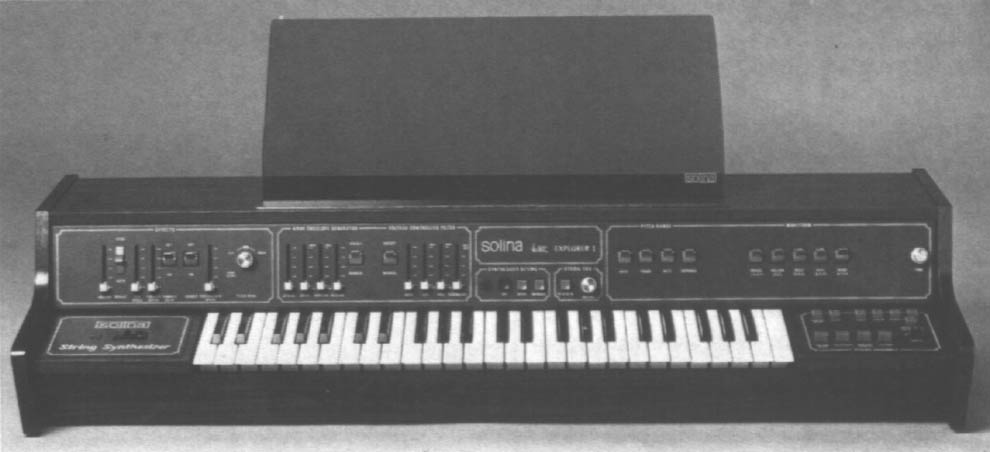
Fresh
Out of the Box
Like a never-used Solina, only better.
We’ve preserved the controls layout and paid homage to the look — and added just the right extras to elevate the Solina experience.
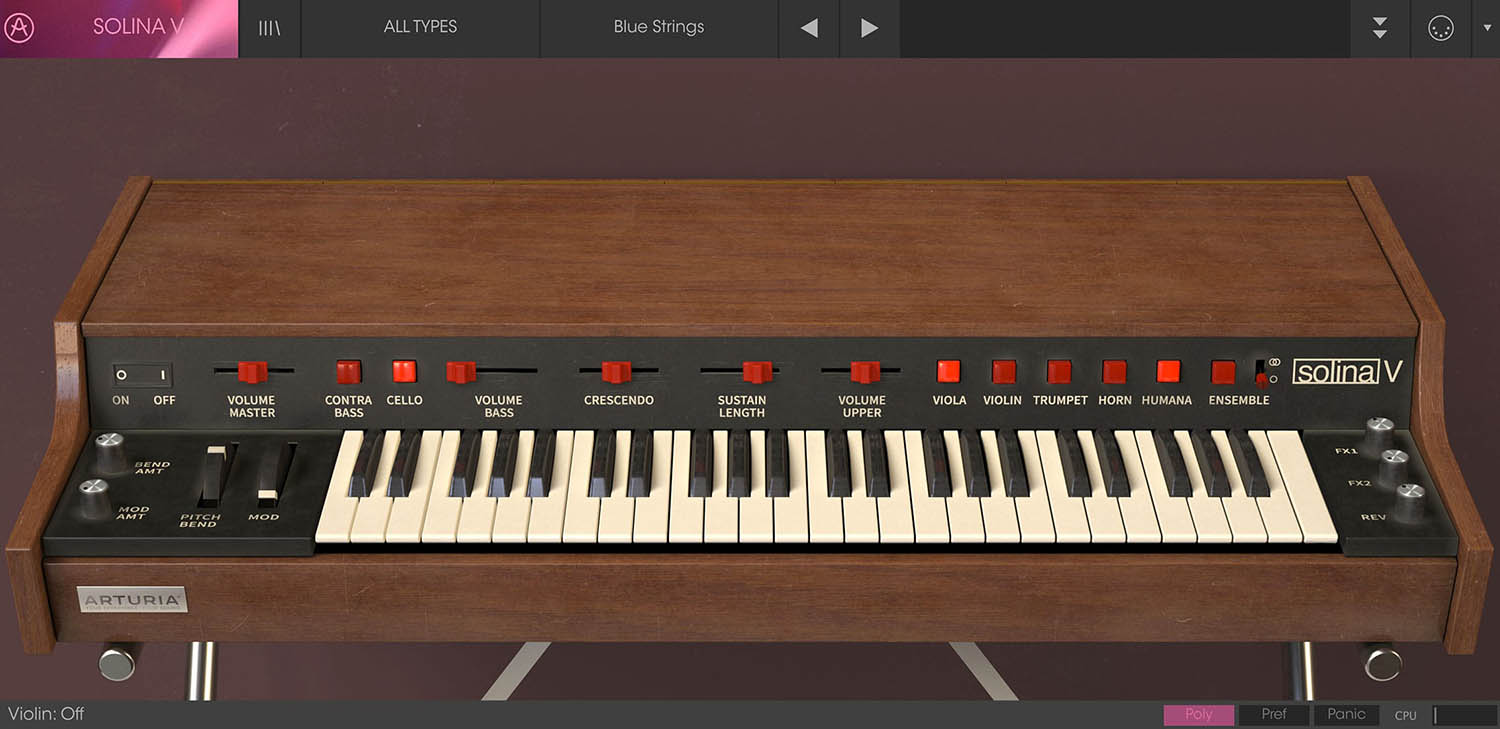
_1
_2
_3
_4
_5
01. Disco Infiltrator
Boogie down with the original Solina voices plus the classic Ensemble effect. Hit the stereo option for an even lusher sound.
02. Human Nature
Solina V borrows a sound from another famous polyphonic keyboard: the “Vox Humana” patch heard on “Cars“ by Gary Numan.
03. Bass Is the Place
Split the keyboard and play bass in the left hand, either layered with the main sound or by itself.
04. Pitch and Mod
Solina V adds pitch and modulation wheels with adjustable depth amounts for more synth-like control over your sound.
05. Retro FX
Dial in period-perfect phaser, chorus, and delays, as well as a convolution reverb to put Solina V in a recording-ready space.
The Solina
Everyone Always Wanted
Heart of a string machine, brains of a synth
If Solina players longed for one thing, it was for their instrument to be more like a synth. Open up the Advanced Panel, and that’s exactly what Solina V is. These features enhance your playing when you want them and get out of your way when you don’t.

This 3-band filter bank comes from the same “Poly” keyboard as the Vox Humana sound, providing surgical creative control over the frequency spectrum.
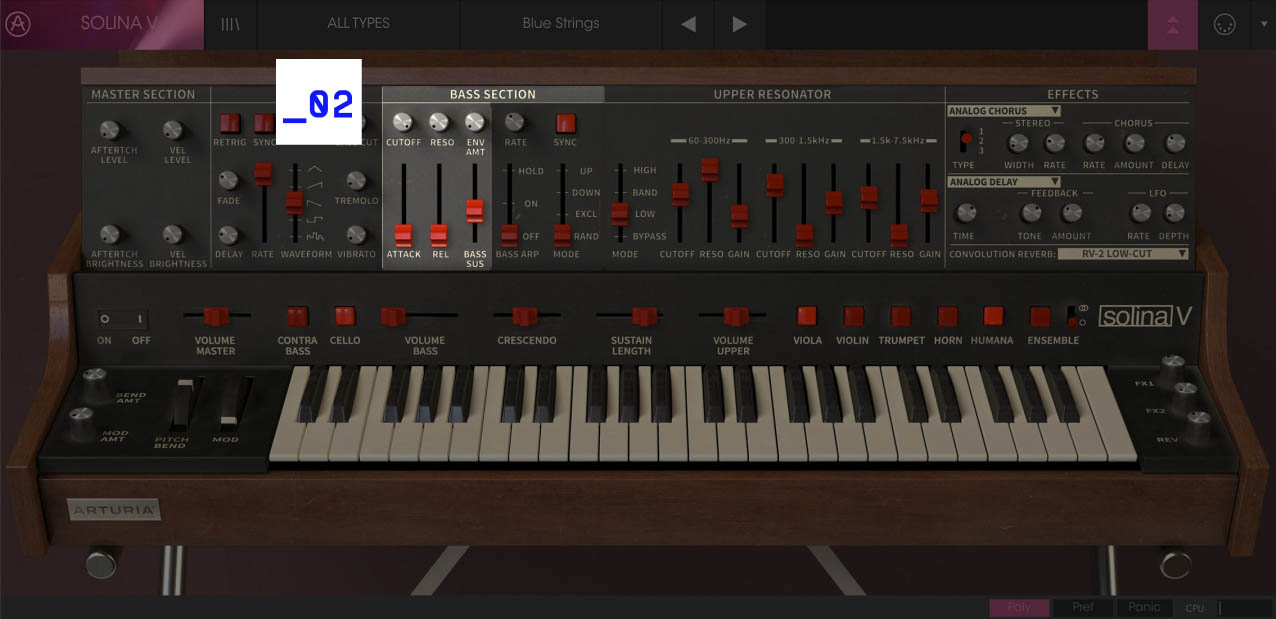
Make the Bass Section bow-wow like a synthesizer with the resonant low-pass filter, and dial up a little sustain for string bass sounds.

A one-octave Arpeggiator just for the Bass Section is perfect for “walking bass” and other animation, and syncs to your master project tempo.
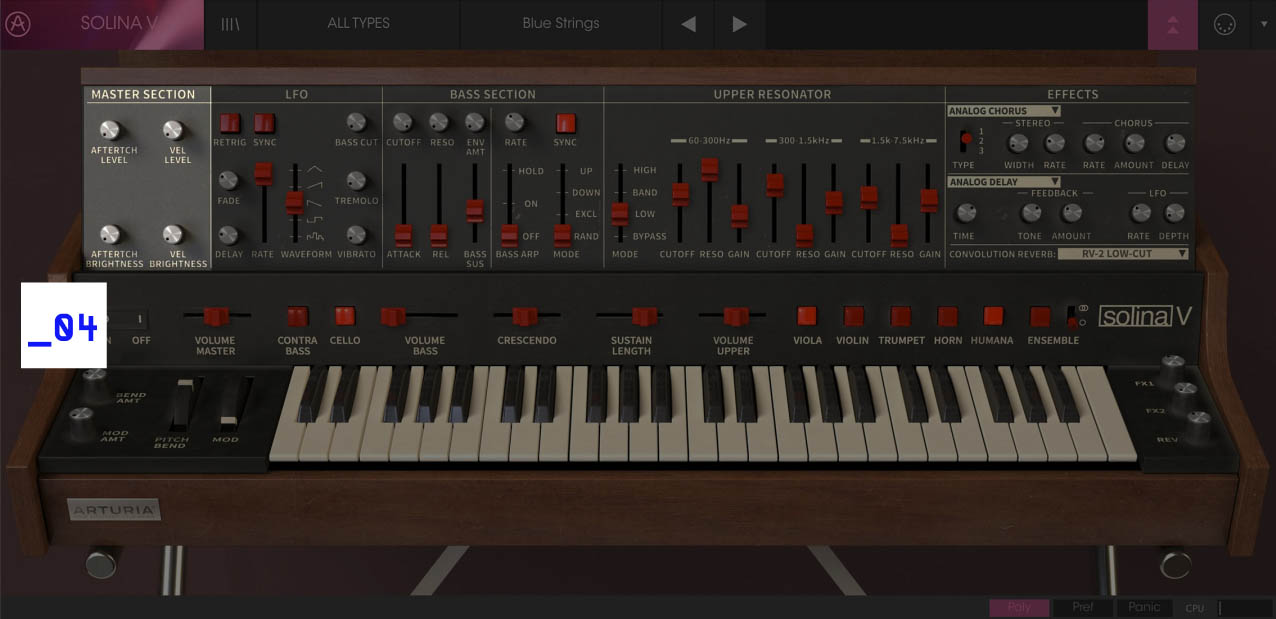
Optimize your keyboard response with velocity and aftertouch control of both volume and brightness.
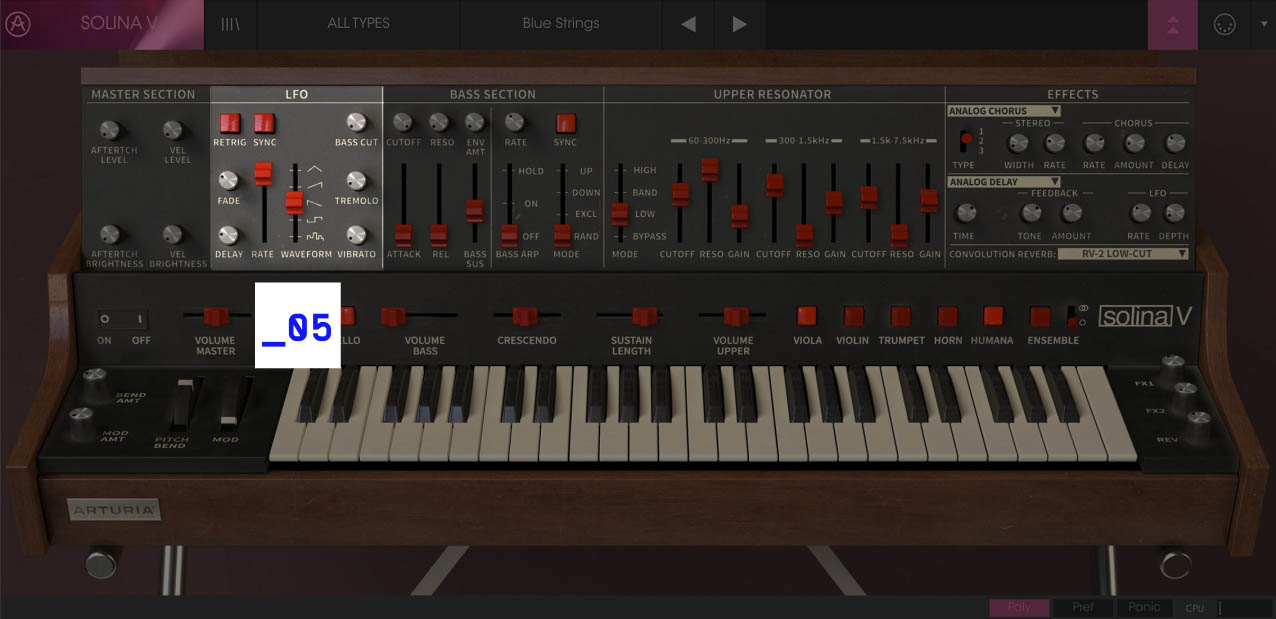
The tempo-syncable LFO offers a myriad of options for modulation brought in by the wheel.

Our FX are curated to complement the Solina sound perfectly. The Convolution Reverb emulates vintage plates and springs.
Hear it
in action
You know all about swirling pads and roller-disco string parts, but Solina V can have a far broader job description in your music.
These artists took its versatility for a test drive and came up with some tracks that prove our point.
Song for Jill
SDG
Pachelbel's Canon
All sounds are from Solina V.
Creepy Carrousel
All sounds except banjo and drums are from Solina V.
Demo
Chillax
All keyboard sounds are from Solina V. The backing track is the “Diamond Strings” preset. The lead is the "Fat in the Middle" preset by Erik Norlander.
Boardeau
Artistscorner
PressClippings

Included in
V collection
Legendary Keyboards Reinvented
This instrument is also part of the V Collection -your complete dream line-up of the legendary synths, organs, pianos and more that made keyboard history. They’re modeled with the most advanced technologies for authentic realism, and enhanced with new creative options. Whether you use it as DAW plugins in the studio or standalone at gigs, V Collection puts the greatest keys of all time at your fingertips for instant inspiration.
Learn More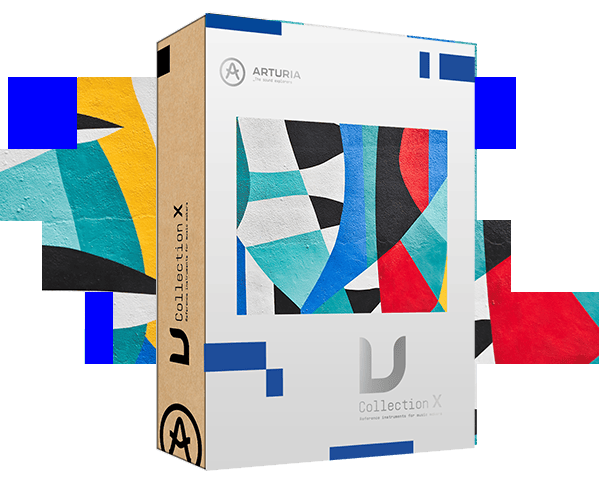
The features
you need

Integrated in-app tutorials guide you through every aspect of the instrument, from individual parameters to tips from our sound designers, so you can focus on the creative stuff. It shouldn't be this easy, but it is!

Arturia Software Center lets you download, organize, and update all of your Arturia software titles in one place, as well as manage all of your licenses across multiple devices. Keep it simple.

Our virtual instruments and plugins are designed to fit right into your setup without hassle. Whatever your style, you can explore sound while enjoying full compatibility with major DAWS, on both Windows and MacOS.

Instantly find the sound that’s in your head with intelligent & streamlined preset browsing. Search with keywords, explore by instrument type, musical style, and more - you can even save your favorites to quickly recall later.

Whether you want the full visual immersion of our classic instrument emulations, or to save precious screen real estate, the interfaces for all of your Arturia virtual instruments can be resized to a scale that suits you.

Instruments come seamlessly mapped for the Arturia KeyLab range - but they’ll place nice with other MIDI controllers too. Instant sound tweaking macros, easy DAW integration, and standalone operation.
TAE® Powered
The exclusive analog modeling technology that makes our emulations indistinguishable from the originals.
By accurately mimicking the characteristics of analog oscillators, filters, and soft clipping, we can provide astonishing component-accurate detail and authentic analog charm in equal measure.
Learn more
Gallery
Main Features
All of the original parameters of the ARP/Eminent Solina string ensemble
Vox Humana sound modeled after the original 1978 Bob Moog's Polysynth
Classic Paraphonic operation as well as selectable Polyphonic mode
1978 Bob Moog’s polysynth resonator section on Upper Section
24dB per octave resonant filter on Bass Section
Arpeggiator on Bass Section
LFO for vibrato, tremolo and filter modulation
Aftertouch and velocity level controls
Solina MK1 and MK2 ensemble modes
3-mode stereo chorus
Stereo dual phaser
Analog delay
Digital sync delay
Convolution reverb with 24 modeled reverbs
150 presets
Platform specifications
Windows
- Win 10+ (64bit)
- 4 GB RAM
- 4 cores CPU, 3.4 GHz (4.0 GHz Turbo-boost)
- 3GB free hard disk space
- OpenGL 2.0 compatible GPU
- ARM processors not supported on Windows
Required configuration
- Works in Standalone, VST, AAX, Audio Unit, NKS (64-bit DAWs only).





Apple
- Mac OS 11+
- 4 GB RAM
- 4 cores CPU, 3.4 GHz (4.0 GHz Turbo-boost) or M1 CPU
- 3GB free hard disk space
- OpenGL 2.0 compatible GPU
Work with ASC
- An elegant and simple solution to help you install, activate, and update your Arturia software instruments.
All manufacturer and product names mentioned on this page are trademarks of their respective owners, which are in no way associated or affiliated with Arturia. The trademarks of other manufacturers are used solely to identify the products of those manufacturers whose features and sound were studied during the development. All names of equipment, inventors, and manufacturers have been included for illustrative and educational purposes only, and do not suggest any affiliation or endorsement by any equipment inventor or manufacturer.


